Main Line Stretches Where the Fastest Runs are Made
RAILWAYS OF BRITAIN - 21
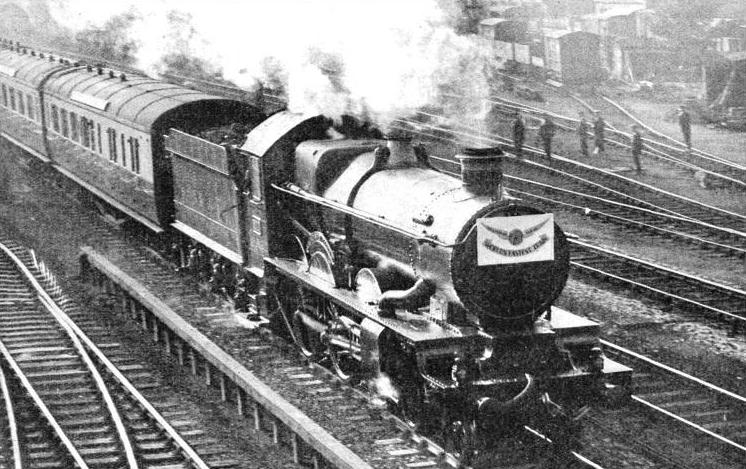
THE WORLD’S FASTEST regular steam train is the “Cheltenham Flyer”, This express is booked to cover the distance of 77.3 miles between Swindon and Paddington in 65 minutes, at an average speed of 71.4 miles an hour.
THERE is a never-failing interest in railway speed, and yet there are few subjects on which such hazy ideas prevail. At the outset it may be said that sixty miles an hour is becoming a by no means uncommon scheduled speed from start to stop; this demands maximum speeds in excess of seventy miles an hour on the way. Eighty miles an hour is frequently attained on suitable down grades, in various parts of the country; but eighty miles an hour on the level is still comparatively rare. Ninety miles an hour is an exceptional speed, even downhill. Although this speed occurs every now and again in records of modern locomotive performance, it requires particularly favourable conditions for its attainment. As to one hundred miles an hour, there is no reason to believe that this speed has ever been attained by a steam locomotive in Great Britain, hauling a passenger train, on more than three occasions at most.
On most main lines the highest speeds are attained over certain well-defined lengths of track, where the gradients are suitable, and the curvature is not too severe. These locations will be specified later, as each company is dealt with. It is not necessarily on the steepest gradients that the highest speeds are to be expected. In very hilly country railways often wind to such an extent as to make some moderation of the speed desirable, as, for example, in the descent from both sides of Shap Summit, on the LMS main line. Long stretches inclined at about 1 in 200, such as the descent from Stoke Summit southwards towards Peterborough - where the LNER “Pacific” engine “Papyrus” attained 108 miles an hour in March, 1935 - or northwards over the same main line from Stevenage to the Ouse Valley near Huntingdon, offer the best opportunities for the development of really fast travelling.
Before proceeding further, readers will probably be interested to know how they may verify the speed of their trains at any point on their journeys. It is a statutory enactment that every railway shall mark out its line with mile-posts at every mile, half-mile, and quarter-mile. Unfortunately the railways have never agreed between themselves as to which side of the line should possess these posts. The LMS main line has them on the down side from Euston to Glasgow and Aberdeen. The LNER similarly locates them on the down side from King’s Cross to Berwick and from Edinburgh to Aberdeen, but changes to the up side between Berwick and Edinburgh. The Great Western favours the up side generally, as does also the Midland Division of the LMS from St. Pancras to Leicester, Leeds, and Carlisle. On the Southern the posts will be found on the down side on practically all its main lines.
The number of seconds spent in travelling over a quarter of a mile, divided into 900, will give the speed in miles per hour.
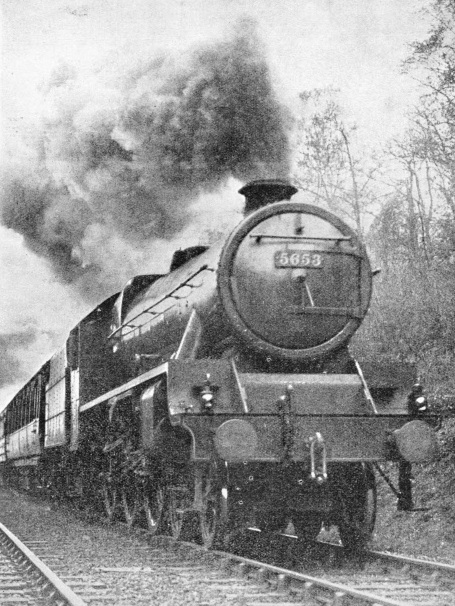
A LONDON-BIRMINGHAM “TWO-HOUR” EXPRESS. The train seen here is drawn by one of the latest LMS 4-6 0 locomotives - Class 5XP - travelling at 65 miles an hour near the south entrance to Watford Tunnel. The express is the 11.30 am from Euston to Birmingham, and covers the ninety-four miles stretch between Euston and Coventry non-stop in ninety-seven minutes. Another Birmingham express, the 5.50 pm from Euston, runs to Coventry in ninety-five minutes.
If it is dark, or if the speed enthusiast is not the fortunate possessor of a window-seat on the mile-post side, it is always possible to take readings of equal accuracy by listening to the “jolts” as his coach passes over the joints in the rails. But if reliable this requires a very acute ear, and a knowledge of the lengths of rail in use. On most British main lines to-day rails are either 60 ft or 45 ft long. It takes twenty-two of the former, and twenty-nine of the latter, to make a quarter of a a mile. To time over a quarter-mile, therefore, it is necessary to start the count at zero, timing from the zero to twenty-two or twenty-nine rail-joints, according to the length of the rails, and avoiding lengths of line through stations where switches and crossings introduce a number of shorter lengths of rail.
We now pass to a consideration of the principal speed trains of Great Britain, and of the points where highest speeds are attained. For some years past the Great Western Railway has held the record for the fastest start-to-stop schedule in Great Britain, and, so far as steam is concerned, in the world. The train concerned is the “Cheltenham Flyer”, booked over the 77.3 miles from Swindon to Paddington in 65 minutes, at an average start-to-stop speed of 71.4 miles an hour. Except for the fact that Swindon is 300 ft higher in altitude than Paddington, the route is level, with a slight descent for must of the way from Swindon to Didcot. Time has been kept on this train without having reached a maximum of 80 miles an hour, but this is very rare. In the normal course an average of 80 or slightly over is kept up for most of the distance, occasionally rising to as much as 87 to 90 miles an hour - a very meritorious achievement on a level track. An engine of the “Castle” class is invariably used, and the load is normally seven coaches, weighing about 230 tons all found, though sometimes this is increased to nine or even ten vehicles. Other trains are booked up from Swindon in 75 and 77 minutes. There is also an up Cheltenham express covering the 91 miles from Kemble to Paddington in 89 minutes.
In the other direction the 11.15 am.and 1.15 pm expresses from Paddington, which for a long time past have covered the 118.3 miles from Paddington to Bristol in two hours, have in recent years abandoned their practice of slipping coaches at Bath in favour of stopping. They now run the 106.9 miles from London to Bath in 102 minutes. The highest speed on this journey is usually reached in descending Dauntsey bank, between Swindon and Chippenham.
Then there are the important trains to the West of England, which diverge from the Bristol line at Reading, and take the Westbury route to Taunton. Probably the hardest daily locomotive proposition on the line is the down “Cornish Riviera Express”, which is indeed a task fit for a “King”. An engine of this type is always used on the “Limited”, as it is affectionately known all down the line. The “Cornish Riviera Express” takes out of Paddington a minimum load of fourteen coaches, weighing with passengers and luggage roughly 500 tons, and is allowed only 169 minutes in the working timetable for the 173.5 miles from Paddington to Exeter. Paddington to Exeter is the longest non-stop run on the GWR, except during the height of the summer season, when this express makes its first stop at North Road, Plymouth, 225.5 miles from London. On this journey the highest speed is usually attained on the long descent from Savernake to Westbury, near Lavington, but is seldom much in excess of 80 miles an hour. Fortunately, when the steep climb of Wellington bank, in the Blackdown Hills west of Taunton, is reached, the weight of the train has been reduced, by the loss of the Westbury and Taunton slip portions, to 360 tons or so. The “Torbay Express” shares the same 169-minute timing from Paddington to Exeter. In 1934 the GWR had more runs booked from start to stop at over a mile a minute than any other British line.
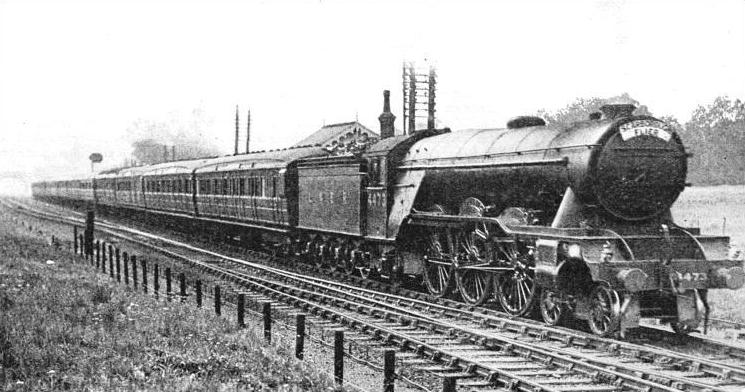
THE “SCARBOROUGH FLIER”, an express which runs in the summer from King’s Cross to Scarborough in four hours five minutes, with only one stop, at York. The distance of 188.2 miles from London to York is covered in 190 minutes non-stop, at an average speed of 59.4 miles an hour. The 4-6-2 locomotive shown in the photograph is No. 4473, “Solario”.
But the highest maximum speeds on the Great Western Railway are generally reached by the two-hour expresses between Paddington and Birmingham. The distance covered is only 110.6 miles, but the booking includes an intermediate stop of three minutes - at High Wycombe or Leamington - and restrictions of speed over curves at Old Oak Common, and at Ashendon and Aynho Junctions. On the down journey it is as the expresses travel northwards off the Chilterns, beyond Princes Risborough, that they touch their maxima, invariably over 80 miles an hour, and occasionally as high as 90. Coming up to London, there are two high-speed stretches, one from Ardley through Bicester to Blackthorn, and the other down from Beaconsficid to Denham, on the “last lap”, both of which may be relied on to produce 80 miles an hour and more.
The London Midland and Scottish Railway boasts the distinction of having a greater mileage booked in its timetables at over 55 miles an hour from start to stop than any other British railway. The “star turn” in the matter of speed is provided by the 5.25 pm express from Liverpool to Euston, which has to cover the 152.7 miles from Crewe to Willesden Junction in 142 minutes, inclusive of slowings through Stafford and Rugby to 40 miles an hour in each instance. It is closely followed by the up “Comet”, with a timing of 128 minutes over the 133.6 miles from Stafford to Euston. Except from Crewe up to Whitmore, there are no troublesome gradients on this section of line, which has been perfectly engineered with long sweeping inclinations of 1 in 330.
Longest Non-Stop Run
Efficient modern locomotives such as the “Royal Scots” may be expected to develop speeds up to and slightly exceeding 80 miles an hour on such fast bookings as these, when descending from Roade to Castlethorpe, near Wolverton, and towards London from Tring, on the crest of the Chilterns, the highest point of the route.
The same remarks apply to various other services almost equally fast. Shortly after midday four expresses are booked into Euston in succession, all of which have completed the final stage of their journey at a start-to-stop average speed of over 60 miles an hour. Of these the most notable is the up “Mancunian”, booked over the 176.9 miles from Wilmslow - a junction south of Manchester where through coaches from East Lancashire are picked up - to Euston in 172 minutes; on this run a dead slowing through Crewe is added to those already mentioned at Stafford and Rugby. The corresponding service in the down direction in 3¼ hours overall, between London and Manchester, is provided by the “Lancastrian”, allowed 176 minutes to its first stop at Wilmslow. The best speed exploits of northbound expresses from Euston are invariably down the long sweep from Tring to Bletchley; though occasionally an “eighty” is attained in descending from Whitmore towards Crewe, where for three miles the gradient steepens to 1 in 177.
Practically all the foregoing expresses are entrusted to 4-6-0 locomotives of the “Royal Scot” class, but the London-Birmingham two-hour services of the LMS are monopolized by the popular and speedy new three-cylinder 4-6-0 engines of the Stanier “5XP” type. The most outstanding trains are probably the 4.35 pm out of Euston, which has to cover the 112.9 miles to Birmingham in two hours, inclusive of stops at both Blisworth and Coventry, and the 4.50 pm from Birmingham, which stops at Coventry and Willesden Junction, and runs the 88.6 miles from Coventry to Willesden in 87 minutes.
None of the trains to and from Scotland attains such high speeds as these; but between Euston and Crewe they are of considerably heavier formation, and north of Crewe there are the formidable ascents to Shap and Beattock summits - respectively 915 and 1,015 ft above the sea - to be surmounted. But they are responsible for records of another description. Throughout the year the up “Royal Scot” is booked to cover the 299.1 miles from Carlisle to Euston in 5½ hours without any intermediate stop, and save for ten weeks in the summer this is the longest non-stop run in the world. Another long LMS run is that of the up “Night Scot”, which takes both Beattock and Shap in one non-stop stride by running the 243.3 miles from Glasgow (Central) to Crewe without a halt. This is a very heavy train, composed almost entirely of sleeping-cars, but it runs on a relatively easy timing of 5 hours 20 minutes. In summer a very long non-stop journey is performed by the northbound “Royal Highlander”, over the 291.8 miles from Crewe to Perth.
Another section of the London, Midland and Scottish system on which high speeds are attained is the Midland Division. Here the conditions differ entirely from those of the Western Division. Linking together many large cities, as did the original Midland Railway, this Division provides a frequent service of trains making relatively short runs from start to stop, but on very close timings, over fairly steep gradients. Going north from St. Pancras, once the expresses have cleared the high ground beyond Luton, they have a glorious racing ground ahead, down to the Ouse Valley, with many miles of 1 in 200 gradient, on which speeds exceeding 80 miles an hour are commonly attained. Coming south, the fastest travelling is made on the descent from Desborough past Kettering, from Sharnbrook Summit down three miles at 1 in 119 towards Bedford, and from St. Albans down to Radlett, where again “eighties” are common. The quickest train on the service is the down “Thames-Forth” express, booked to run from St. Pancras to Nottingham, 123.5 miles - including a dead slowing through Kettering - in 129 minutes. Other fast timings, observed by numerous expresses, are 105 minutes for the 99.1 miles from Leicester to St. Pancras, and 75 minutes for the 72.1 miles up from Kettering.
The “Breakfast Flyer”
On the London and North Eastern Railway, as with the LMS, it is not such famous trains as the “Flying Scotsman” that boast the highest booked speeds. The fastest train on the LNER is the so-called “Breakfast Flyer” from Leeds to King’s Cross, leaving at 7.50 am. This train’s lightning career really begins at Grantham. From here the 105.5 miles to London must be covered in the level one hundred minutes, and as this distance includes lengthy gradients at 1 in 200, and a very severe slack over the curve through Peterborough Station, some very fast running is needed. Down from Stoke Summit speed invariably rises well above the “eighty” mark, and frequently touches a rate of 90 miles an hour.
On the down journey from King’s Cross the first taste of speed is obtained as the trains sweep down from Potter’s Bar to the Lea Valley, just beyond Hatfield; but the principal speed stretch begins at Stevenage, and continues almost uninterruptedly downhill for over thirty miles, to Huntingdon. The maximum is usually reached at Three Counties, four miles north of Hitchin, and is often well over 80 miles an hour, even with the heaviest trains. The LNER “Pacifics” specialize in heavier load haulage than any other locomotive type in Britain, and such expresses as the 1.20 midday “Scotsman” out of King’s Cross commonly load to over 500 tons.
Equally fine achievements, proportionately to their smaller size, stand to the credit of the thirty-year-old Great Northern “Atlantics”, which are still entrusted with the important Pullman workings between King’s Cross and Leeds. The “Queen of Scots” covers the 185.7 miles between London and Leeds in 194 minutes down and 193 minutes up, with seven heavy Pullmans weighing a little under 300 tons. The schedule is very often bettered. Over the 156 miles between King’s Cross and Doncaster an average speed just exceeding a mile a minute is demanded throughout. Except in the height of the summer, when the “Flying Scotsman” is making its 392.7-mile break - the longest non-stop run in the world - between King’s Cross and Edinburgh, these London-Leeds runs take the premier place for length on the LNER. The “West Riding Pullman” stops additionally at Wakefield (175.8 miles from London), and is made up to eight cars, but is nearly as fast south of Doncaster.
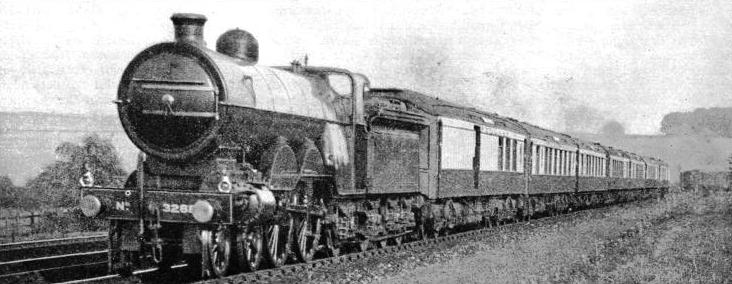
THE “QUEEN OF SCOTS”. The London and North Eastern Railway’s famous Pullman express near Grantham, Lincolnshire. The train runs between King’s Cross and Edinburgh and Glasgow. The “Queen of Scots” covers the 185.7 miles between London and Leeds non-stop in 194 minutes down and 193 minutes up. The normal load is seven Pullmans weighing nearly 300 tons. The locomotive is an “Atlantic”.
Also noted for its high maximum speeds is the Great Central section of the LNER. As with the Midland Division of the LMS, this has steep gradients, light trains, but very close timings. The fastest train on the service is the down “Newspaper”, leaving Marylebone terminus at 2.32 am. This makes three mile-a-minute runs in succession from start to stop, over the Brackley-Rugby-Leicester-Nottingham stretch - 23.9 miles in 24 minutes; 19.9 miles in 20 minutes; and 22.5 miles in 22 minutes. After allowing for getting up speed and slowing down again, these bookings require a whole succession of 80-miles-an-hour maxima for their maintenance.
Of the principal passenger trains, the 3.20 pm from Marylebone is probably the best known. Generally made up to seven coaches, it has to run the 103.1 miles from Marylebone to Leicester in 109 minutes. Top speeds of over 80 miles an hour are generally attained on the long 1 in 176 downhill stretches from Charwelton to Braunston (just south of Rugby), and from Ashby to Leicester. Equally high speeds are also occasionally reached on the steeper pitch from Wendover down to Aylesbury, which is preceded by a hard climb - six miles at 1 in 105 - from Rickmansworth up to the crest of the Chilterns at Amersham. Similarly the 4.55 pm down has to reach Leicester in 108 minutes, and the 2.20 pm from Manchester and the 7.30 am from Sheffield have both to run up from Leicester to Marylebone in 109 minutes. In this direction the fastest running is chiefly concentrated in a downhill section some seventeen miles long, beginning just to the north of Brackley. Much of the express work on the Great Central section is still performed by the handsome 4-4-0 “"Directors”, but they are being gradually supplanted by the three-cylinder 4-6-0 “Sandringhams”.
Little high speed can be expected on the Great Eastern Section of the LNER, because of steep grades and numerous slowings for curves. A timing such as 2½ hours non-stop between Liverpool Street and Yarmouth, which is in operation during the summer months, is really good in consideration of these difficulties, even though the distance is no greater than 121.7 miles. The highest speeds on this section may be looked for coming down the Brentwood bank, towards Romford, on the up journey, and, going north, in the deep “dip” where the Stour Valley is crossed at Manningtree, between Colchester and Ipswich, as well as through Diss, on the Ipswich and Norwich line. Rebuilt 4-6-0 inside cylinder engines of the Great Eastern “8500” type, and “Sandringham” class three-cylinder 4-6-0’s work the principal trains over this section.
The principal “racing ground” of the North Eastern area of the LNER is across the Great Plain of York, from York to Darlington, 44.1 miles away. This is almost dead level, and for many years before the war it boasted the fastest timing in the British Empire, as the then 12.20 pm express was booked from Darlington to York in 43 minutes. There are still two expresses with the same 43-minute schedule - one of them the heavy 8.15 am breakfast car express from Newcastle to King's Cross; but they are now outstripped in speed by numerous other British bookings. North of Newcastle, and still more so on the LNER lines in Scotland, grades are too steep and slacks too frequent to invite anything in the way of high speed. In view of the formidable 1 in 42 pull up Cowlairs bank out of Glasgow, and one or two points on the way where colliery workings demand reduced speed, 55 minutes for the 47.3 miles from Glasgow to Edinburgh is a faster time than might appear at first sight.
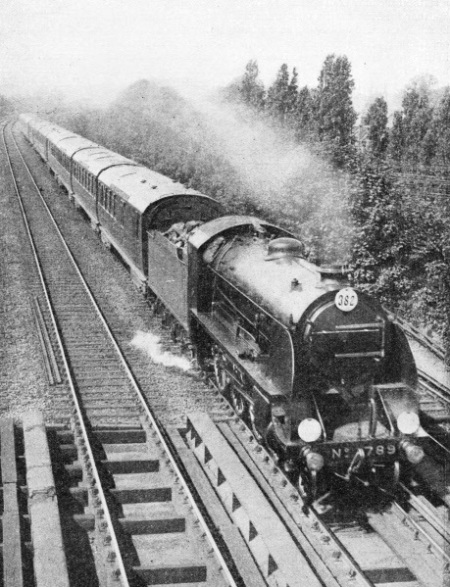
THE “BOURNEMOUTH LIMITED” of the Southern Railway. This express runs every weekday between London and the Dorset coast, covering the 108 miles non-stop between Waterloo and Bournemouth Central in 120 minutes. The 4-6-0 locomotive is of the “King Arthur” class.
But it is, perhaps, the Southern Railway that gives the most surprising results in the matter of speed. Between Salisbury and Exeter the old London and South Western main line is a switchback of extremely steep gradients, culminating in the climb from just beyond Axminster up to Honiton Tunnel, for 4½ miles as steep as 1 in 80. But fortunately the alinement is so good that practically unlimited speeds can be run down the banks, giving a helpful impetus for the succeeding climb. Thus any single journey on a non-stop express from Salisbury to Exeter may yield a whole crop of top speeds exceeding 80 miles an hour - at Gillingham, Sherborne, Axminster, and finally at Broad Clyst, between Sidmouth Junction and Exeter. Such speeds are, indeed, essential when so short a time as 96 minutes (only 93 minutes for the down morning “Newspaper”) is allowed for this distance of 88 miles. Frequently it is improved on by the “King Arthur” 4-6-0’s, which do magnificent work over this route with trains of up to fourteen heavy coaches, or 475 tons all found. The “Atlantic Coast Express”, or the “ACE” of the Southern Railway, as it is known by a combination of its initials, leaves Waterloo at 11 am, and is the principal train over this route.
Between Waterloo and Salisbury the gradients are flatter, but longer and more sweeping. There is a long pull for fifty miles from Waterloo out to Worting Junction, two miles west of Basingstoke, which is shared with the expresses for Southampton and Bournemouth. Of the latter the chief is the “Bournemouth Limited”, covering the distance of 108 miles between Waterloo and Bournemouth Central in the even two hours - incidentally, the longest non-stop run on the Southern system. It is on the up journey that the highest sustained speeds are generally reached.
Speed on the Brighton Line
Expresses from Bournemouth and from Salisbury travel at high speeds continuously from Basingstoke onwards until it becomes necessary to moderate the rate of travel somewhat on entering the electrified suburban area at Surbiton. It is by no means unusual to cover this 36 miles at an average speed of well over 70 miles an hour for the whole distance.
On the Central Division the main line breasts in succession three summits - at Quarry, Balcombe, and Clayton - with long intermediate descents to Horley and Hayward’s Heath. At the bottom of these dips maximum speeds of 75 miles an hour were common in steam days. Now that electrical working is in use, however, the uphill running of the trains is so fast that the high downhill speeds of pre-electrification days are seldom needed.
The Eastern Division of the Southern is notorious for its extremely difficult gradients. Over sections where high-speed running is possible every advantage is taken of the speed capabilities of modern Southern locomotives. For example, the up 80-minutes trains from Folkestone to Charing Cross have to reach their stop at Waterloo Junction, 69.1 miles, in 76 minutes. In view of the unusually steep climb from Tonbridge to Knockholt, and slow running necessary through London Bridge, this leaves no time to spare. On the down journey the steep descent from Sevenoaks to Tonbridge often produces maximum speeds in excess of 75 miles an hour. The handsome “Schools” class 4-4-0’s are responsible for the working of these trains; but the boat trains are mostly entrusted to “Lord Nelson” type 4-6-0’s.
Not much opportunity for speeding is given on the Margate main line, which is extraordinarily difficult, but the sharp descents from both sides to the viaduct at Farningham Road can generally be relied on to give a top speed of 75 miles an hour, now that the 4-6-0 “King Arthurs” are used on this service.
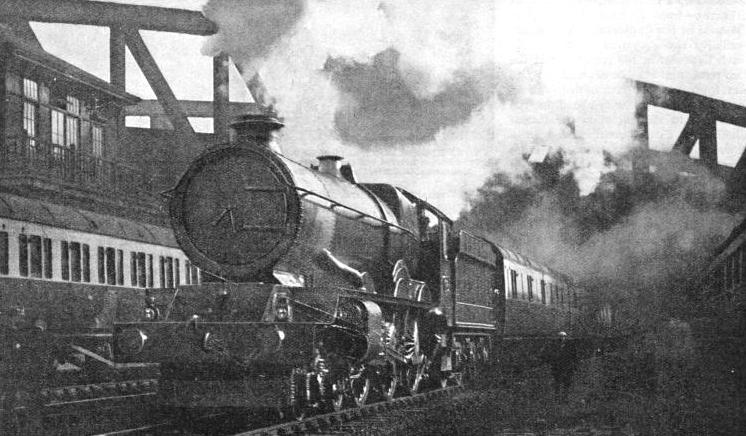
THE “CORNISH RIVIERA EXPRESS”, drawn by a “King”, leaving Paddington. In summer this Great Western train covers the 225½ miles between London and Plymouth in four hours without a stop. In the winter months it stops at Exeter.
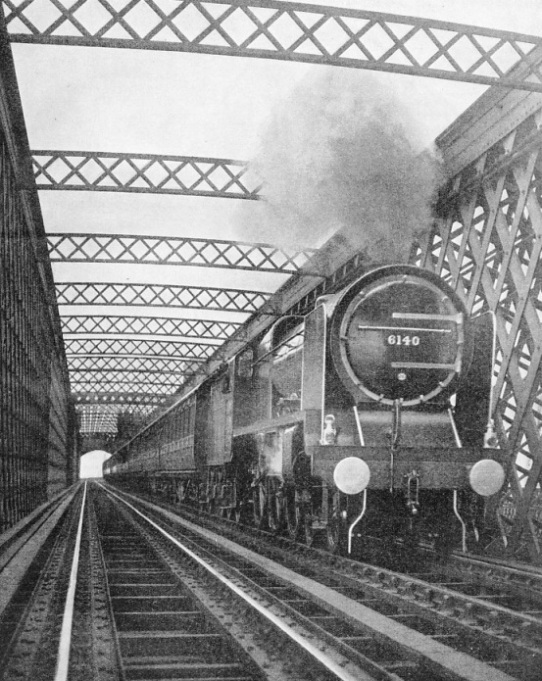
“HECTOR”, one of the LMS “Royal Scot”
4-6-0 express locomotives, hauling the 5.25pm from Liverpool to Euston on 18 July 1932, the first day of its accelerated schedule. This train set up a record (since beaten) between Crewe and Willesden, gaining five minutes on the booked time of 142 minutes for the 152.7 miles between those points. The train is seen passing over Runcorn Bridge, between Liverpool and Crewe.
You can read more on “The Atlantic Coast Express”, “The Cheltenham Flyer”, “The Royal Scot” and “The Silver Jubilee” on this website.









